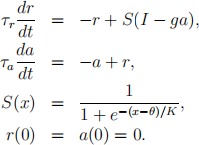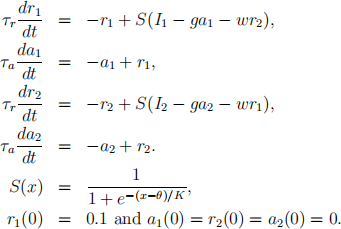STAT 42610 - Assignment 4 Winter 2024
Hello, dear friend, you can consult us at any time if you have any questions, add WeChat: daixieit
STAT 42610 - Assignment 4
Winter 2024
1. Firing rate adaptation and competition models.
In this problem you will consider the effects of spike rate adaptation on firing dynamics. Particular attention will be given to two population models which inhibit one another, thereby setting up a competitive dynamic.
(a) Consider the single population model with spike frequency adaptation:

The first equation is a standard Wilson-Cowan equation modeling the overall firing rate, r, of a population of neurons. The second equation models an adaptation current, a, which is driven by spiking activity. We model adaptation of r as a simple subtractive current in the first equation, −ga, where g > 0 is a parameter describing the overall gain of adaptation. Create an Euler scheme to simulate and plot against time the (r(t), a(t)) solution for θ = −0.1, K = 0.1, τr = 1, τa = 100, and chose (I, g) = {(0.2, 0.1),(0.7, 0.1),(0.2, 0.7),(0.7, 0.1)}.
(b) Use your code to estimate the steady state firing rate, rs = limt→∞ r(t), and plot it over the (I, g) plane (find a reasonable range). Comment on the effect of adaptation on the steady state firing rate of the population.
(c) Now consider the double population model with spike frequency adaptation and mutual inhibition:

With τa, τr, K, and θ given above and w = 0.3 and g = 0.5 plot the time series r1(t) and r2(t) for the input pairings (I1, I2) = (0.2, 0.7) and (I1, I2) = (0.5, 0.5). By repeating this with w = 0, comment on how the coupled network (r1, r2) acts like a competitive system, where I1 and I2 are different inputs being presented simultaneously to two antagonistic networks.
(d) Consider the same network as in (b) yet set w = 0.45. Study the network dynamics when I1 = I2 = I over a range of I ∈ (0, 1). You should find a range of I where the (r1, r2) dynamics are periodic, i.e at some time points r1 suppress r2 and at other time points r2 suppress r1. This type of dynamic response is reported in perceptual studies of ambiguous visual stimuli, such as the Necker cube (http : //en.wikipedia.org/wiki/Neckercube). Plot an example of the rhythmic dynamic between r1 and r2. Ranging over I ∈ (0, 1) plot the minimum and maximal value of r1(t) during a cycle of the rhythm.
(e) For the same parameters in (c) let the inputs be asymmetric; I2 = I1 +∆I. Study how the range of I1 where rhythmic activity exists is dependent on ∆I.
2. Hopfield Networks.
Consider a network of N neurons with the state of neuron i being Si ∈ {−1, 1}. Let the update be asynchronous over the network, where on every timestep a randomly chosen neuron’s state is updated according to:

Let the network encode p random patterns, where the state of neuron i in pattern µ, ξiµ , has value 1 with probability 0.5 and -1 with probability 0.5. A Hopfield network is characterized by the symmetric coupling:

Further, assume no self connections (Jii = 0 for all i). The coherence of the network’s state with pattern µ is:

(a) Write a numerical code that simulates the above system. Let the initial state of the network be Si(0) = ξi 1 and take N = 1000 with each realization having 30000 updates. As derived in class, the probability of that a neuron stays in the correct state is:

If we neglect correlations then the probability that the entire network remains in the correct state is ρN . Let α = p/N be the pattern density. In class we showed that for large N and α < αc we have that ρN ∼ 1, while for α > αc we have ρN ∼ 0. Thus αc is the storage capacity of the network and with elementary analysis we showed that:

(b) Let 〈m1(T)〉 be the average coherence of the network state at time T = 30000 with the loaded state ξ1. Here, the expectation 〈·〉 is over input patterns ξµ and update sequence. Plot 〈m1(T)〉 for α ∈ (0.5αc, 2αc) and verify that storage is degraded when α > αc.
(c) Explore how N affects the results of part (b).
2024-02-26